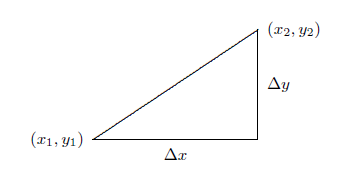1.3: Distance Between Two Points; Circles
( \newcommand{\kernel}{\mathrm{null}\,}\)
Given two points (x1,y1) and (x2,y2), recall that their horizontal distance from one another is Δx=x2−x1 and their vertical distance from one another is Δy=y2−y1. (Actually, the word "distance'' normally denotes "positive distance''. Δx and Δy are signed distances, but this is clear from context.) The actual (positive) distance from one point to the other is the length of the hypotenuse of a right triangle with legs |Δx| and |Δy|, as shown in Figure 1.3.1. The Pythagorean theorem then says that the distance between the two points is the square root of the sum of the squares of the horizontal and vertical sides:
distance=√(Δx)2+(Δy)2=√(x2−x1)2+(y2−y1)2.
For example, the distance between points A(2,1) and B(3,3) is
√(3−2)2+(3−1)2=√5.

As a special case of the distance formula, suppose we want to know the distance of a point (x,y) to the origin. According to the distance formula, this is √(x−0)2+(y−0)2=√x2+y2.
A point (x,y) is at a distance r from the origin if and only if
√x2+y2=r,
or, if we square both sides:
x2+y2=r2.
This is the equation of the circle of radius r centered at the origin. The special case r=1 is called the unit circle; its equation is
x2+y2=1.
Similarly, if C(h,k) is any fixed point, then a point (x,y) is at a distance r from the point C if and only if
√(x−h)2+(y−k)2=r,
i.e., if and only if
(x−h)2+(y−k)2=r2.
This is the equation of the circle of radius r centered at the point (h,k). For example, the circle of radius 5 centered at the point (0,−6) has equation (x−0)2+(y−−6)2=25, or x2+(y+6)2=25. If we expand this we get x2+y2+12y+36=25 or x2+y2+12y+11=0, but the original form is usually more useful.
Graph the circle x2−2x+y2+4y−11=0.
Solution
With a little thought we convert this to
(x−1)2+(y+2)2−16=0
or
(x−1)2+(y+2)2=16.
Now we see that this is the circle with radius 4 and center (1,−2), which is easy to graph.


